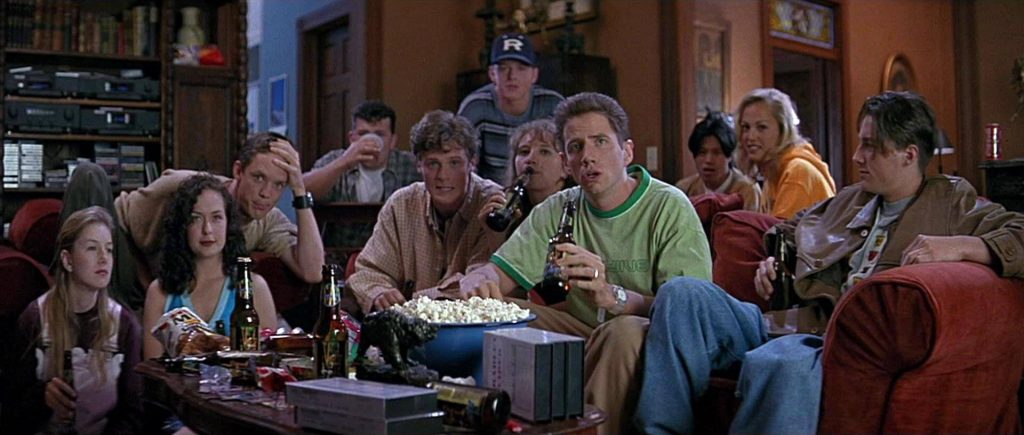When Scream hit theaters in 1996, it became the poster child for a new type of horror: one that was explicitly grounded in a world where characters were intimately familiar with all the genre tropes that had been established by decades of scary movies that came before it. It features characters who are in a horror film, but also consumers of horror: victims as well as voyeurs. Smart, self-aware, and unabashedly meta, Scream is made for a generation of audiences who have the same cinematic knowledge as its characters, growing up in an era of video rental stores that broadened their reference base beyond any other generation. But it’s hardly alone in that. Rather, Scream is part of a larger movement of the 1990s that goes beyond horror, made up of directors making films that play with conventions and contain cinematic references that assume, on behalf of its audiences, a certain level of film literacy only possible with the advent of video rental culture.
From the very first scene in Scream, director Wes Craven makes it clear that his film will be steeped in the legacy of its illustrious predecessors. While Casey Becker (Drew Barrymore) is on the phone with the killer, he draws her into a trivia game about horror movie killers, an explicit indication from Craven that Scream will directly engage with the genre, rather than pretending to exist in a world where no one had even the slightest working knowledge of scary movies.
Jamie Kennedy’s Randy Meeks blurs the line between the insular film world and our own multiple times. While he’s working at a video store, he explains to Stu (Matthew Lillard) where everyone is going wrong in their investigations of the murders, lamenting that if people only watched more scary movies, the killer would be obvious to them. Later at Stu’s party, he goes over the basic rules to survive a horror movie with the assembled teenagers, once more bridging the gap between two worlds, acting as both an active participant in the narrative and a Cassandra-like figure who exists somehow apart. The party scene in particular emphasizes the significance of this interplay between the characters and the audience: At one point, we’re watching a character watching characters who are, in turn, watching a horror film. And then we have our two villains, who have not only planned their reign of terror based on the lessons they’ve learned from on-screen killers, but cite specific movie characters as inspiration for their unmotived murder spree. They’ve designed their actions not out of any personal preference, but seemingly in order to orchestrate the perfect horror movie ending.
The concept of characters grappling with the dangerous implications of their own internal legacy of scary stories is not unique to Scream. In fact, we see other examples of this throughout the 1990s, although they often explore more traditional horror tales rather than exclusively relying on just scary movies. Candyman and Urban Legend both feature characters who are explicitly interacting with urban legends, demonstrating once again their diegetic knowledge of horror that goes beyond what we see in similar films from previous decades.

But this awareness of cinema goes well beyond the horror genre. During the 1990s, many directors came to prominence who received their cinematic education not from film school, as was common among the New Hollywood directors of the late 1960s and 1970s, but from constant exposure to film by way of the local video store. Filmmakers like Quentin Tarantino would constantly reference older movies in Pulp Fiction and Reservoir Dogs, largely for his own entertainment, but also secure in the knowledge that there were plenty of audience members who would also be in on the joke. (Or at least pick up on enough of his visual homages to appreciate what he was doing.)
This was a fairly new phenomenon: the expectation that your audience would likely have a baseline of cinematic knowledge that they could draw on to better engage with your film. Tarantino is a fairly extreme example, considering how obscure many of his references are, but it’s notable that in no previous generation would mainstream audiences have as much consistent access to their favorite films and the opportunity to watch them enough to have a chance to pick on these sorts of cinematic references. French New Wave directors made it their business to study the films that came before them, attending the cinema multiple times a day and working as critics to analyze the elements that would make up everything they watched on screen. But for the first time, the average film enthusiast could watch (and, crucially, rewatch) the works of Ernst Lubitsch and Nicholas Ray and Jean-Luc Godard from the comfort of their own home if they wanted to.
To be clear, these are two separate concepts. One refers to the cinematic knowledge that characters have within the text of a film, and how it influences their actions in the narrative. The other is external, identifying not just the knowledge of older films that directors would have, but their confidence that audiences would have the savvy to engage with their references and homages on a deeper level. The two ideas are interconnected, though: Both point to a cinematic landscape that would not be possible a generation earlier, before video rentals gave audiences a broader knowledge base to draw on.
When we look at horror in the 1990s, and Scream in particular, it’s clear that there was a burgeoning appetite for characters who themselves had a little cinematic acumen, who acted as though they had seen at least one horror movie in their entire lives. The young audiences of the 1990s responded to seeing themselves on screen, in all their cynical, self-aware glory, and weren’t in the market for scream queens with little savvy. Sidney makes it to the end of Scream not because she’s a virgin, as Randy would argue, but because she knows how horror movies work.

